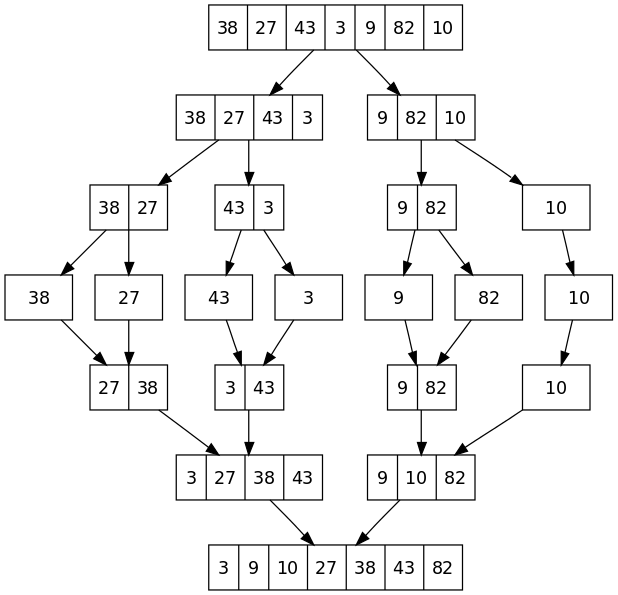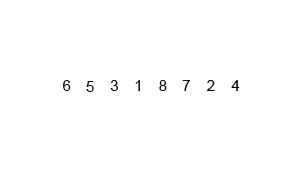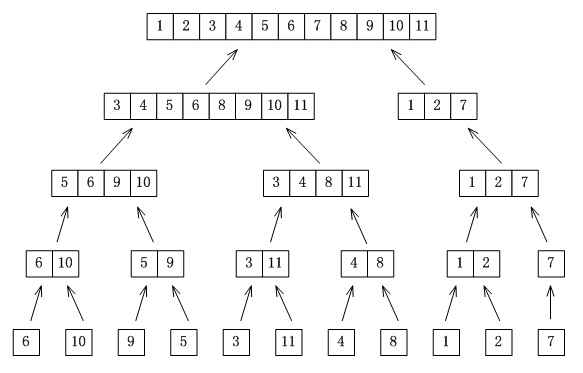C#版 - LeetCode 148. Sort List 解题报告(归并排序小结)
二路归并排序其实要做两件事,:
(1)“分解”——将序列每次折半划分。
(2)“合并”——将划分后的序列段两两合并后排序。
1) If head == NULL or 只有一个元素
return head.
2) else 将链表分为两个部分,
pSlow是中点; /* pFast, pSlow指针找到中点 */
3) 分别对front,back排序
sortList(head); // 前半段
sortList(pSlow->next); // 后半段
4) 合并已排序的front, back
merge(*pFront, *pBack);
单链表递归实现 自顶向下
AC代码:
#include <iostream>
using namespace std;
struct ListNode {
int val;
ListNode *next;
ListNode(int x) : val(x), next(NULL) {}
};
class Solution {
public:
ListNode* sortList(ListNode* head) {
ListNode *pFast, *pSlow,*pFront,*pBack;
pFast=head;
pSlow=head;
if(head==NULL || head->next==NULL) return head;
else {
while(pFast->next!=NULL && pFast->next->next!=NULL)
{
pFast=pFast->next->next;
pSlow=pSlow->next; //快慢指针找到中间节点,当快指针到末尾,慢指针恰好到中点
}
// 从中间结点断开,中间结点的next域置为NULL,中间结点及其以前的部分为前半段,中间结点后一个节点到最后为后半段
pFast=pSlow;
pSlow=pSlow->next;
pFast->next=NULL;
pFront=sortList(head); // 递归地排序前半段
pBack=sortList(pSlow); // 递归地排序后半段
return merge(pFront,pBack); // 合并前后两段序列
}
}
ListNode* merge(ListNode* head1, ListNode *head2) // 将两个已经有序的序列进行合并
{
ListNode *res, *p;
if(head1==NULL) return head2;
if(head2==NULL) return head1;
if(head1->val < head2->val)
{
res=head1; // 结点需要整体赋值,不能只给val属性赋值
head1=head1->next;
}
else {
res=head2;
head2=head2->next;
}
p=res;
while(head1!=NULL && head2!=NULL)
{
if(head1->val < head2->val)
{
p->next=head1;
head1=head1->next;
}
else {
p->next=head2;
head2=head2->next;
}
p=p->next;
}
if(head1!=NULL) p->next=head1; // 挂接上去
else if(head2!=NULL) p->next=head2;
return res;
}
};
// 以下为测试部分
/*
int main()
{
ListNode *pOut;
ListNode *head=new ListNode(5);
head->next=new ListNode(8);
head->next->next=new ListNode(7);
head->next->next->next=new ListNode(12);
head->next->next->next->next=new ListNode(4);
Solution sol;
pOut=sol.sortList(head);
while(pOut!=NULL)
{
cout<<pOut->val<<" ";
pOut=pOut->next;
}
cout<<endl;
return 0;
}
*/链表 非递归实现 自底向上
非递归实现的思想和递归正好相反,原来的递归过程是将待排序集合一分为二,直至排序集合就剩下一个元素位置,然后不断的合并两个排好序的数组。所以非递归思想为,将数组中的相邻元素两两配对。用merge函数将他们排序,构成n/2组长度gap为2的排序好的子数组段,然后再将他们排序成长度为4的子数组段,如此继续下去,直至整个数组排好序。
先将1+1(gap=1)个只有1个结点的链表按二路归并的方法加到tail结点的后面,然后更新tail;接着将2+2(gap=2)个分别有序的链表按二路归并的方式加到当前tail结点的后面,然后更新tail;gap每次扩大2倍,直到从split()函数(从head结点开始分离出长度为gap的链表)的返回值为NULL时结束外层循环。
例如: 下图是6 10 9 5 3 11 4 8 1 2 7的自底向上的归并过程...
链表 非递归
AC代码:
// To-Do: 链表非递归实现,自底向上
#include <iostream>
using namespace std;
struct ListNode{
int val;
ListNode *next;
ListNode(int x): val(x), next(NULL) {}
};
class Solution {
public:
ListNode *split(ListNode *head, int size) // 从head结点开始分离出长度为size的链表,并将第size-1个结点的next置为NULL,返回剩下的链表
{
for(int i = 1; i < size; i++)
{
if(head != NULL) head=head->next; // 从head结点开始分离出长度为size的链表,分离前总长度>size时,可以顺利到结尾,如果不足size,剩下的链表为NULL,分离到的长度为实际长度(<size的某值)
}
if(head == NULL) return NULL;
ListNode *p = head->next;
head->next = NULL;
return p;
}
ListNode* merge(ListNode *head1, ListNode *head2, ListNode *tail) // tail始终指向已合并链表的末尾,tail之后的结点值是有序的
{
while(head1 && head2) // head1、head2均不为NULL时
{
if(head1->val < head2->val) // 将值较小的结点挂到tail之后
{
tail->next = head1; // head1的值较小,将该结点挂到tail后
tail = tail->next;
head1 = head1->next;
}
else {
tail->next = head2; // head2的值较小,将该结点挂到tail后
tail = tail->next;
head2 = head2->next;
}
}
tail->next = (head1 == NULL) ? head2 : head1;
// 如果head1先为空,即head1对应的链表较短时,把head2剩下的那些结点挂到tail后面; 反之同理,同时为NULL时皆可
while(tail->next != NULL)
tail = tail->next;
return tail;
}
ListNode* sortList(ListNode* head)
{
if(head == NULL || head->next == NULL)
return head;
int len = 0;
ListNode *cur = head;
while(cur)
{
len ++;
cur = cur->next;
}
ListNode *front, *back;
ListNode *pTemp = new ListNode(0); //pTemp保存临时更小的那个节点
ListNode *tail = pTemp;
pTemp->next = head; // 将head挂到pTemp之后
for(int size = 1; size < len; size <<= 1) // 每次归并都分两路,链表的宽度的初始值为1,(2,4,8,....),size*2
{
cur = pTemp->next;
tail = pTemp;
while(cur) // 当前结点后面还有结点时继续循环
{
front = cur;
back = split(cur, size); //从当前结点向后分离出size长的链表front
cur = split(back, size); //从当前结点向后分离出size长的链表back
tail = merge(front, back, tail); // 将front链表、back链表以二路归并的方式加到tail后去
}
}
return pTemp->next;
}
};
// 以下为测试
int main()
{
Solution sol;
ListNode *pOut;
ListNode *head=new ListNode(5);
head->next=new ListNode(8);
head->next->next=new ListNode(7);
head->next->next->next=new ListNode(12);
head->next->next->next->next=new ListNode(-3);
pOut=sol.sortList(head);
while(pOut!=NULL)
{
cout<<pOut->val<<" ";
pOut=pOut->next;
}
cout<<endl;
return 0;
}数组 递归实现:
#include <cstdio>
using namespace std;
void Merge(int arr[], int left, int right, int mid) {
//归并操作
int length = right - left + 1;
int beginA = left, beginB = mid + 1; //设置两个标志,分别指向两个已排序序列的起始位置
int i, j = 0;
int *pArr = new int[length]; // 创建临时辅助数组
// if (pArr == NULL) { printf("Memory allocated error\n"); return; }
while(beginA <= mid)
{
if(arr[beginA] > arr[beginB]) pArr[j++] = arr[beginB++];
if(arr[beginA] < arr[beginB]) pArr[j++] = arr[beginA++];
if(beginB > right) break;
}
while(beginA <= mid) pArr[j++] = arr[beginA++]; //将小元素添加到辅助数组
while(beginB <= right) pArr[j++] = arr[beginB++]; //同上
for(i = 0; i < length; i++) arr[left++] = pArr[i]; //把排序好的部分移回arr数组中
delete[] pArr; // 释放辅助数组
}
void mergeSort(int arr[], int left, int right)
{
//对数组递归地进行二路归并
int mid =(left + right)/2;
if(left >= right) return;
mergeSort(arr,left, mid); //递归的归并排序左边
mergeSort(arr, mid+1, right); //递归的归并排序左边
Merge(arr,left,right,mid); //合并
}
int main()
{
int arr[]={5,2,6,3,9,10,8};
int len = sizeof(arr)/sizeof(int);
mergeSort(arr,0,len-1);
for(int i = 0; i <= len-1; i++) {
printf("%d ",arr[i]);
}
return 0;
}数组 非递归实现:
#include <cstdio>
using namespace std;
// 将数组中连续的两个子序列合并为一个有序序列
void Merge(int* arr, int *tempArr, int bIndex, int mIndex, int eIndex)
{
int gap = eIndex - bIndex; //合并后的序列长度
int i = 0; //记录合并后序列插入数据的偏移
int j = bIndex; //记录子序列1插入数据的偏移
int k = mIndex; //记录子序列2插入数据的偏移
while(j < mIndex && k < eIndex)
{
if(arr[j] <= arr[k])
{
tempArr[i++] = arr[j];
j++;
}
else
{
tempArr[i++] = arr[k];
k++;
}
}
if(j == mIndex) //说明序列1已经插入完毕
{
while(k < eIndex)
tempArr[i++] = arr[k++];
}
else { //说明序列2已经插入完毕
while(j < mIndex)
tempArr[i++] = arr[j++];
}
for(i = 0; i < gap; i++) //将合并后序列重新放入arr
arr[bIndex + i] = tempArr[i];
}
// 自底向上的归并排序(非递归)
void mergeSort(int* arr, int len)
{
int *tempArr = new int[len]; //临时存放合并后的序列
int gap = 1; //初始有序子序列长度为1
while(gap < len)
{
int i = 0;
for(; i + 2*gap < len; i += 2*gap)
Merge(arr, tempArr, i, i + gap, i + 2*gap);
if(i + gap < len)
Merge(arr, tempArr, i, i + gap, len);
gap *= 2; //有序子序列长度*2
}
delete[] tempArr;
}
// 以下为测试
int main()
{
int arr[]={5,2,6,3,9,10,8};
int len = sizeof(arr)/sizeof(int);
mergeSort(arr, len);
for(int i = 0; i <= len-1; i++) {
printf("%d ",arr[i]);
}
return 0;
}另外,如果要进行原址归并,不占用其他空间,编程珠玑上提出了一个很神奇的算法,代码如下:
#include<cstdio>
using namespace std;
//此函数用于一个反转数组
void reverse(int arr[], size_t size)
{
int left = 0,
right = size - 1,
tmp = 0;
while(left < right)
{
tmp = arr[left];
arr[left] = arr[right];
arr[right] = tmp;
left++;
right--;
}
}
//手摇法 通过三次反转操作交换两个子序列的位置,两个子序列内部的排序不变。
void swap_blocks(int arr[], size_t size, size_t lft_size) {
reverse(arr, lft_size);
reverse(arr + lft_size, size - lft_size);
reverse(arr, size);
}
void in_place_merge(int arr[], size_t size, size_t mid) //原地归并
{
size_t lft_s = 0, rit_s = mid, rmove;
while (lft_s < rit_s && rit_s < size)
{
while (lft_s < rit_s && arr[lft_s] <= arr[rit_s])
{
lft_s++;
}
rmove = 0;
while (rit_s < size && arr[lft_s] > arr[rit_s])
{
rmove++;
rit_s++;
}
swap_blocks(arr + lft_s, rit_s - lft_s, rit_s - lft_s - rmove);
lft_s += rmove;
}
}
int main()
{
int arr[]={5,2,6,3,9,10,8};
int len = sizeof(arr)/sizeof(int);
in_place_merge(arr,0,len-1);
for(int i = 0; i <= len-1; i++) {
printf("%d ",arr[i]);
}
return 0;
}相关链接:
自顶向下的归并排序 - 太阳落雨 - CSDN http://blog.csdn.net/cjf_iceking/article/details/7921443
自底向上的归并排序 - 太阳落雨 - CSDN http://blog.csdn.net/cjf_iceking/article/details/7920153
归并排序(递归实现+非递归实现+自然合并排序) - geeker - 博客园 http://www.cnblogs.com/liushang0419/archive/2011/09/19/2181476.html
C#版 - LeetCode 148. Sort List 解题报告(归并排序小结)的更多相关文章
- 【LeetCode】148. Sort List 解题报告(Python & C++)
作者: 负雪明烛 id: fuxuemingzhu 个人博客: http://fuxuemingzhu.cn/ 目录 题目描述 题目大意 解题方法 日期 题目地址:https://leetcode.c ...
- [LeetCode] 148. Sort List 解题思路
Sort a linked list in O(n log n) time using constant space complexity. 问题:对一个单列表排序,要求时间复杂度为 O(n*logn ...
- C++版 - Leetcode 400. Nth Digit解题报告
leetcode 400. Nth Digit 在线提交网址: https://leetcode.com/problems/nth-digit/ Total Accepted: 4356 Total ...
- C++版 - Leetcode 69. Sqrt(x) 解题报告【C库函数sqrt(x)模拟-求平方根】
69. Sqrt(x) Total Accepted: 93296 Total Submissions: 368340 Difficulty: Medium 提交网址: https://leetcod ...
- LeetCode: Insertion Sort List 解题报告
Insertion Sort List Sort a linked list using insertion sort. SOLUTION: 使用一个dummynode 创建一个新的链,将旧的节点插入 ...
- 【LeetCode】Sort Colors 解题报告
[题目] Given an array with n objects colored red, white or blue, sort them so that objects of the same ...
- 【LeetCode】147. Insertion Sort List 解题报告(Python)
[LeetCode]147. Insertion Sort List 解题报告(Python) 标签(空格分隔): LeetCode 作者: 负雪明烛 id: fuxuemingzhu 个人博客: h ...
- 【LeetCode】Permutations II 解题报告
[题目] Given a collection of numbers that might contain duplicates, return all possible unique permuta ...
- 【LeetCode】Largest Number 解题报告
[LeetCode]Largest Number 解题报告 标签(空格分隔): LeetCode 题目地址:https://leetcode.com/problems/largest-number/# ...
随机推荐
- P3805 【模板】manacher算法
#include <bits/stdc++.h> #define up(i,l,r) for(register int i = (l);i <= (r); i++) #define ...
- 软件测试---测试模型(V、W、H)
一.V测试模型 1.V模型示意图: 单元测试:又叫模块测试,针对软件设计中的最小单位—>程序模块 集成测试:又叫组装测试,通常在单元测试的基础上,将所有程序模块进行有序.递增测试. 系统测试:把 ...
- CentOS 6下升级Python版本
CentOS6.8默认的python版本是2.6,而现在好多python组件开始只支持2.7以上的版本,比如说我今天遇到的pip install pysqlite,升级python版本是一个痛苦但又常 ...
- eclipse启动时要求高版本jdk的问题
在eclipse.ini文件首行添加 -vm C:\Program Files\Java\jdk1.8\jdk1.8.0_131\bin https://blog.csdn.net/wanlin77/ ...
- <笔记>原生PHP访问TP模板变量
在模板中,原生PHP可以直接访问模板变量,不过如果模板变量是数组,要访问数组中元素时不能使用"."符号,只能通过数组['元素名']的方式
- git的命令行操作
1.初始化本地的git仓库git init,代码存放在这里,git会自动对我们的代码进行管理备份. 2.设置用户信息,设置用户名:git config --global user.name " ...
- Python3.* 和Python2.*的区别
许多Python初学者都会问:我应该学习哪个版本的Python.对于这个问题,我的回答通常是“先选择一个最适合你的Python教程,教程中使用哪个版本的Python,你就用那个版本.等学得差不多了,再 ...
- C++与java中的赋值操作符
#include <iostream> using namespace std; class BankAccount{ private: double balance; public: B ...
- Promise(一)
每个Promise对象就是一个值的代理,这个值在Promise创建时可以是未知的.Promise对象允许你为异步事件的成功操作和失败操作分别绑定对应的处理方法,让异步方法可以像同步方法那样返回值,但不 ...
- day_4流程控制之分支结构循环结构及for循环
复习一下昨天的内容 1:变量的命名规范 只能由数字 字母 及下划线组成 不能以数字开头 不能与系统关键字重名 _开头有特殊含义 __开头__结尾的变量是魔法变量 支持大小驼峰 ,但建议使用下划线连接语 ...



